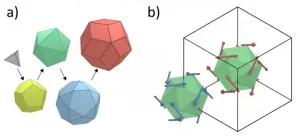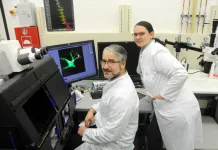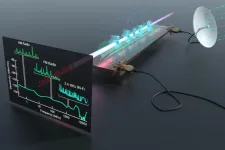(Press-News.org) Cardiac patients who also have diabetes will be able to do their rehabilitation exercises more safely, thanks to the world's first guidance on the subject, which has been published by international experts including a Swansea University academic.
The guidance will be a crucial resource for healthcare professionals, so they can help the growing number of cardiac rehabilitation patients who also have diabetes.
The guidance, approved by international diabetes organisations, was drawn up by a team including Dr. Richard Bracken of the School of Sports and Exercise Sciences, College of Engineering and the Diabetes Research group, located in the Medical School at Swansea University.
Physical exercise and improving activity levels are central parts of cardiac rehabilitation, which aims to boost the health and fitness of people with heart problems.
At present, around 25% of participants attending cardiac rehabilitation in Europe, North America and Australia also have diabetes. This figure is increasing, largely because there are some common risk factors for both cardiovascular disease and diabetes, especially obesity and sedentary lifestyles.
While being more active is crucial for cardiac rehabilitation patients, a major obstacle is that many worry that the exercise itself will put them at risk.
For those patients who also have diabetes, however, there are additional worries, especially about falling blood sugar levels leading to hypoglycaemia. Fear of having a "hypo", which can lead to dizziness, disorientation, anxiety and many other symptoms, is one of the main barriers stopping people with diabetes from incorporating exercise into daily life.
This helps explain why cardiac patients who also have diabetes have are less likely to take up and continue a cardiac rehabilitation programme than those without diabetes.
This is where the new guidance can make a difference. It focuses on managing levels of blood sugar during rehabilitation activities, to reduce the risk of acute glycaemic problems during exercise. The aim is to give more confidence to patients with diabetes, making them more likely to do the rehabilitation exercises and keep at it, improving their overall health.
The new guidance gives health professionals clear advice covering areas such as:
-The interactions that can occur between medicines that patients with both cardiovascular disease and diabetes may be using
-The best types of exercise for these patients, the ideal intensity level, and the safest times of day
-The different requirements for patients with Type 1 and Type 2 diabetes
The guidance, contained in a position statement, was approved by the British and Canadian Associations of Cardiovascular Prevention and Rehabilitation, the International Council for Cardiovascular Prevention and Rehabilitation and the British Association of Sport and Exercise Sciences.
Dr Richard Bracken, one of the authors, and a diabetes expert from the A-STEM research team in Swansea University School of Sports and Exercise Sciences and the Lifestyle research group lead in the Diabetes Research Group, Medical School, said:
"Exercising safely is essential to improve the health of patients with cardiovascular problems.
A rising number of these patients also have diabetes, so it's essential that cardiac rehabilitation programmes meet their needs.
This expert guidance will mean health professionals can design cardiac rehabilitation to give patients with diabetes the reassurance they need to start and stick with the programme, boosting their overall health."
The guidance was published in the British Journal of Sports Medicine doi: 10.1136/bjsports-2020-102446
INFORMATION:
Scientists at Bielefeld University's Faculty of Physics have succeeded for the first time in imaging the SARS-CoV-2 coronavirus with a helium ion microscope. In contrast to the more conventional electron microscopy, the samples do not need a thin metal coating in helium ion microscopy. This allows interactions between the coronaviruses and their host cell to be observed particularly clearly. The scientists have published their findings, obtained in collaboration with researchers from Bielefeld University's Medical School OWL and Justus Liebig University Giessen, in the Beilstein Journal of Nanotechnology.
'The study shows that the helium ion microscope is suitable for imaging coronaviruses - so precisely that the interaction between virus ...
People undergoing long-term dialysis are almost 4 times more likely to die from COVID-19 and should be prioritized for vaccination, found a new Ontario study published in CMAJ (Canadian Medical Association Journal).
"As the COVID-19 pandemic proceeds, focused efforts should be made to protect this population from infection including prioritizing patients on long-term dialysis and the staff treating them for SARS-CoV-2 vaccination," writes Dr. Peter Blake, provincial director, Ontario Renal Network, Ontario Health, and professor, Schulich School of Medicine and Dentistry, Western University, ...
It is necessary to develop additional COVID-19 vaccines, as different vaccine approaches have their advantages and disadvantages and may work synergistically. Researchers at Karolinska Institutet in Sweden now report that they have developed a prototype vaccine against SARS-CoV-2 using a DNA vaccine platform that is inexpensive, stable, easy to produce, and shows a good safety profile. A study published in Scientific Reports shows that the vaccine induces potent immune responses in mice.
The vaccine, called DREP-S, is administered as DNA and is based on a DNA-launched self-amplifying RNA (DREP) platform developed at Karolinska ...
Between chemistry classes, gemstones, and electronics, the idea of crystals, substances with an ordered and periodic arrangement of atoms is quite common. But about 40 years ago, a strange particle was discovered by scientists that hasn't become commonplace in our world yet: quasicrystals. These are structures with curious atomic arrangements, which, while superficially similar to crystals, lack periodicity despite being ordered. Because of their structures, quasicrystals exhibit symmetries forbidden to crystals and are endowed with interesting properties that crystals cannot show, ...
The unmet HIV prevention and treatment needs of female sex workers and especially their male clients could contribute substantially to ongoing HIV transmission in South Africa, according to a new study led by researchers at the University of Bristol, UK.
The researchers used mathematical modelling to look at the contribution of commercial sex, sex between men, and other heterosexual partnerships to HIV transmission in South Africa.
They found that, over a ten-year period (2010-19), sex between female sex workers and their paying clients contributed 6.9 per cent of new HIV infections, while ...
In order to fight pathogens, mast cells regulate inflammatory reactions of the immune system. Both mast cells and neutrophils are white blood cells and are critical for the body's immune defense. A team of scientists around the immunologist Prof. Dr. Anne Dudeck and the bioengineer Jan Dudeck has discovered a crucial aspect of the communication between mast cells and neutrophils. These new findings may allow for developing innovative, targeted therapeutic strategies to dampen allergic responses and inflammatory reactions. The results have been published ...
ADELPHI, Md. -- A new quantum sensor can analyze the full spectrum of radio frequency and real-world signals, unleashing new potentials for soldier communications, spectrum awareness and electronic warfare.
Army researchers built the quantum sensor, which can sample the radio-frequency spectrum--from zero frequency up to 20 GHz--and detect AM and FM radio, Bluetooth, Wi-Fi and other communication signals.
The Rydberg sensor uses laser beams to create highly-excited Rydberg atoms directly above a microwave circuit, to boost and hone in on the portion of the spectrum being measured. The Rydberg atoms are sensitive to the circuit's voltage, enabling the device to be used as a sensitive probe for the wide range of signals in the RF spectrum.
"All ...
People traditionally think that lungs and limbs are key innovations that came with the vertebrate transition from water to land. But in fact, the genetic basis of air-breathing and limb movement was already established in our fish ancestor 50 million years earlier. This, according to a recent genome mapping of primitive fish conducted by the University of Copenhagen, among others. The new study changes our understanding of a key milestone in our own evolutionary history.
There is nothing new about humans and all other vertebrates having evolved from fish. The conventional understanding has been that certain fish shimmied landwards roughly ...
A global team of researchers has developed a new strategy for fast and reliable antibody tests, which can quantify the immune response induced by vaccination and reveal the timeline and stage of pathogen infection.
Led by Professor Martin Hegner, Principal Investigator in CRANN and Trinity College Dublin's School of Physics, the team's one-step quantitative antibody tests are conducted using (blood) serum and are on a par with the gold-standard, enzyme-linked immunosorbent assay (ELISA) technique.
The major advantage of the newly developed nano technique with respect to ELISA tests is that it is equally ...
ATLANTA - Researchers at Yerkes National Primate Research Center, Emory University, have developed a COVID-19 vaccine that has proven safe and effective in mice and monkeys. Results from this National Institute of Allergy and Infectious Diseases (NIAID)-funded study are published online today in Immunity.
The Emory MVA COVID-19 vaccine approaches inducing protective immunity via modified vaccinia Ankara (MVA), a harmless version of a poxvirus that is well-known for its use in HIV/AIDS vaccines. Like the Moderna and Pfizer COVID-19 vaccines, the Emory MVA COVID-19 vaccine ...





